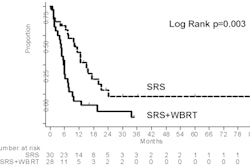
Their results reveal that in terms of dosimetric accuracy, VMAT is comparable to step-and-shoot intensity-modulated radiation therapy (IMRT), but VMAT cuts treatment time considerably (International Journal of Radiation Oncology, Biology, Physics, in press, doi: 10.1016/j.ijrobp.2009.03.033).
The head-to-head study considered replanned treatment schemes for 11 prostate cancer patients. The prescription dose for the target volume was set at 86.4 Gy. All plans produced for VMAT delivery (177 equally spaced beams, single gantry rotation) and IMRT delivery (five-field approach) had to conform to the same clinical dose-volume constraints. Treatment plans were normalized to maximize target coverage without exceeding the dose limit to any nearby critical organs.
The VMAT algorithm used for treatment planning was essentially the same as that incorporated by Varian Medical Systems (Palo Alto, CA) in its RapidArc system, but with a few minor modifications, lead author Pengpeng Zhang, Ph.D., told medicalphysicsweb. Plan quality was rated according to a range of parameters, including percentage of target volume receiving 95% of the prescribed dose, mean dose received by the target, and probability of tumor control. Efficiency was based on monitor units delivered and delivery time. Risks of secondary cancer induced by radiation leaks were also estimated and compared.
The findings were more or less consistent with previous published analyses of VMAT, according to Zhang. This was despite the fact that the treatment-planning problem chosen by the researchers was more complex than the prostate cancer plans studied by other groups. Nonetheless, despite the extra constraints, the team members still concluded that the VMAT and IMRT plans would be "clinically indistinguishable." Dosimetric differences between the two were statistically significant on occasions, but these differences were still small.
One area of divergence for the VMAT and IMRT plans was dose conformality. VMAT plans were more conformal in the middle-dose level compared with IMRT, but less conformal in the low-dose range owing to the 360° delivery. This difference in delivery mechanism was also evident on dose distribution maps. Regions outside the treatment field received very little radiation on the static field IMRT plans, whereas the same areas of tissue received 5% to 10% of the prescription dose on VMAT plans.
"For many sites, this may not be a significant concern; however, it could be problematic for some sites such as pediatric tumors," the authors noted. "This increase in low-dose irradiated volume that occurs with VMAT should be carefully considered on a site-by-site basis before clinical implementation."
Another area where the two methods differed noticeably was delivery efficiency. Beam-on time was reduced by up to 55% with the VMAT technique. Faster treatment delivery could be particularly useful in patients receiving hypofractionated or single high-dose treatment, where intrafraction motion has more potential to cause harm.
The VMAT algorithm has the potential for further improvements, according to Zhang. Three parameters are currently optimized during VMAT planning: gantry rotation, multileaf collimator motion, and dose rate. The Memorial Sloan-Kettering researchers are working with Varian to add in a fourth variable -- collimator angle trajectory -- the results of which were presented at the annual meeting of the American Association of Physicists in Medicine (AAPM).
"I personally think this is an exciting approach and will bring VMAT to the next level," Zhang said.
By Paula Gould
Medicalphysicsweb contributing editor
August 24, 2009
Related Reading
VMAT provides same treatment as IMRT in half the time, October 31, 2008
© IOP Publishing Limited. Republished with permission from medicalphysicsweb, a community Web site covering fundamental research and emerging technologies in medical imaging and radiation therapy.



















